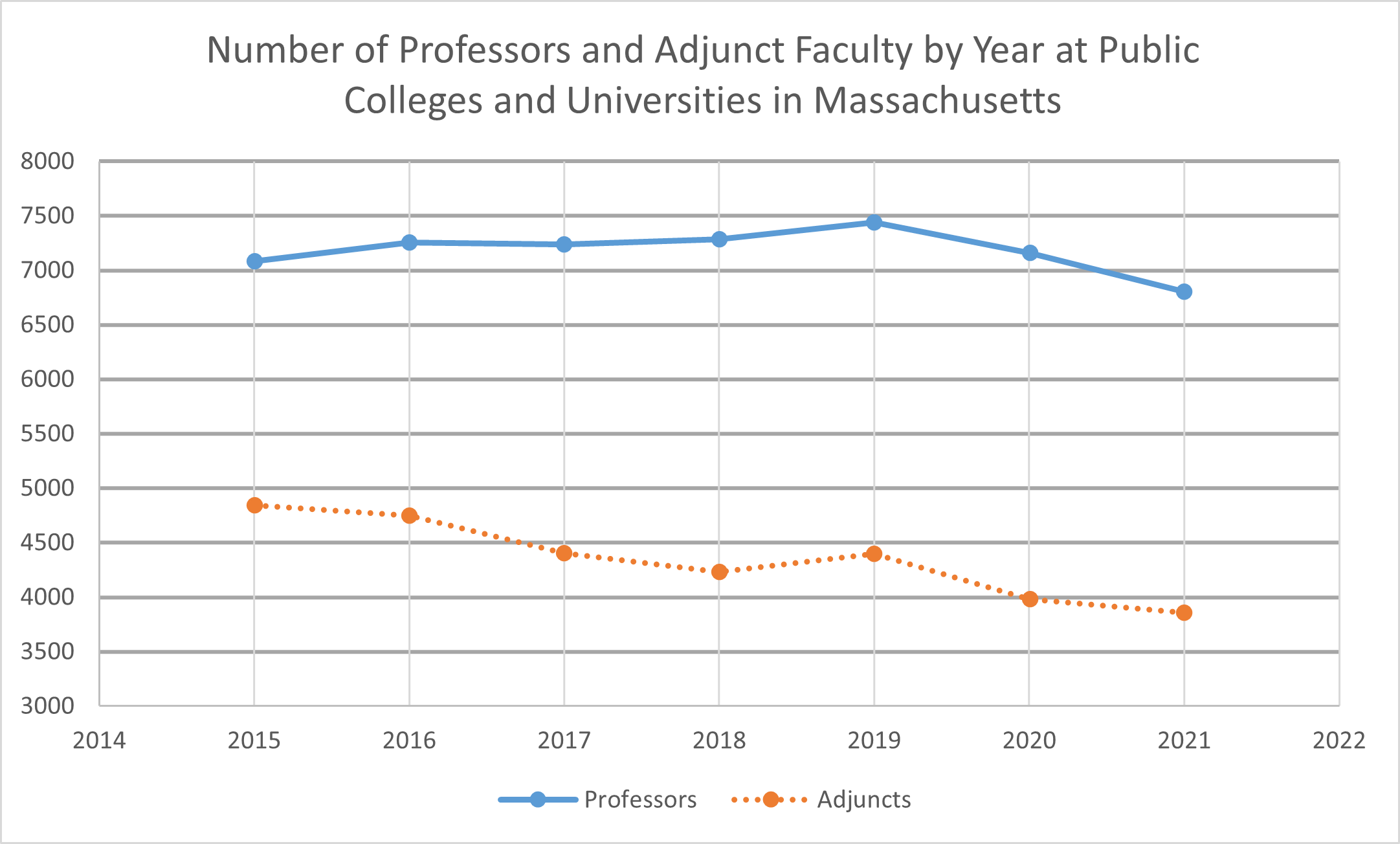With Declining Enrollment, Public Colleges in Massachusetts Cut Back Adjunct Faculty Positions
National Trends

Figure 1: Annual Enrollment at Public Colleges and Universities in Massachusetts by academic year. Source: US Department of Education, National Center for Education Statistics.
The disquieting rise of adjunct positions at universities is creating what some have called an “army of temps” and others “the lowest rung in a caste system.” But at public colleges and universities in Massachusetts, one could more accurately call them “disposable.”
Adjunct faculty often teach introductory courses. They teach as few as one class per semester on a temporary basis. Many of these faculty members end up teaching at multiple colleges to make ends meet.
Since the 1970’s, these types of positions have gradually taken over higher education. Colleges and universities are replacing tenure-track positions with adjuncts who do the job at a lower cost.
With today’s declining enrollments, colleges cut adjunct faculty positions before cutting professor. Adjunct faculty are simply more disposable.
What is happening in Massachusetts?

Figure 2: A graph showing the number of professors vs. adjunct faculty at public colleges in Massachusetts. Notice that the decrease in adjunct faculty is more significant than the decrease in “professor” positions. “Professor” positions are any position that includes the word “professor” or “prof” to exclude adjunct, part-time, visiting and emeritus professors. Included in “professor” positions are associate, assistant, and interim professors. The data comes from the Massachusetts Comptroller’s Office and position titles are reported by the colleges. One challenge in creating this graph was determining which positions to include and exclude since positions titles are reported differently by every college. One college might use the title “professor” while another college might report the same position as “assistant mathematics prof.” The data presented here is publicly available through the Pioneer Institute’s MassOpenBooks website.
Enrollment at public colleges in Massachusetts has been declining since 2015. Over five years, enrollment decreased by 10.4 percent, or around 30,000 students, according to the US Department of Education (see Figure 1).
As enrollment declines, so does the number of adjunct faculty. From 2015-2021, enrollment decreased 10.4 percent, the number of adjunct faculty decreased 20.4 percent, and the number of professors decreased by only 4.0 percent (see Figure 2). This change shows that public colleges in Massachusetts are reducing adjuncts much more quickly than professors.
Pay has also improved more slowly for adjunct positions. From 2015-2021, pay increased 13.8 percent for professors and only 8.4 percent for adjuncts at public colleges in Massachusetts. The average pay for an adjunct position is slightly less than $12,000 in 2021, far below the average for professor positions.
Institutions with Big Changes

Figure 3: This graph shows how the number of adjunct faculty has changed at the institutional level and only includes institutions for which sufficient data is available. Springfield Technical Community College is in red to draw attention to it as one of the few public institutions in Massachusetts that has increased its number of adjunct faculty since 2015. The data presented here is publicly available through the Pioneer Institute’s MassOpenBooks website.
Not every public college in Massachusetts is cutting adjunct positions at the same rate. The biggest decreases have been from the institutions with the largest number of adjunct faculty. Those colleges are Bristol Community College in Fall River, Massasoit Community College in Brockton, and the University of Massachusetts system (UMass). These three alone account for over half the decrease in adjunct positions at public colleges and universities in Massachusetts.
One notable outlier is Springfield Technical Community College (STCC), which has increased its adjunct faculty by almost 70 percent since 2015. At the same time, professor positions at STCC decreased by almost 25 percent: well above average. This suggests that STCC is replacing some of its long-term positions with adjuncts.
STCC’s increase in adjunct faculty is surprising because the college’s enrollment is down by 31.2 percent since 2015. Perhaps STCC is trying to cut costs by replacing professors with adjunct instructors, but it is not easy to tell by only looking at the numbers.
Conclusion
Declining enrollment at public colleges and universities in Massachusetts has coincided with faculty cutbacks. On average, adjunct instructors have taken a bigger hit than professors. Their pay has increased more slowly, and there are far fewer positions for adjuncts than there were in 2015. These cutbacks are understandable, given current trends in higher education.
Colleges with lower enrollments are making cut-backs that disproportionately impact adjunct professors. That means the field is increasingly inhospitable for young people trying to pursue a career in higher education.
About the Author:
Joseph Staruski is a government transparency intern with the Pioneer Institute. He is currently a Master of Public Policy Student at the University of Massachusetts, Amherst. He was previously an opinions columnist with the Boston College student newspaper The Heights and an Intern with the Philadelphia Public School Notebook. He has a BA in Philosophy and the Growth and Structure of Cities from Haverford College. Feel free to reach out via email, linkedin, or write a letter to Pioneer’s Office in Boston.



